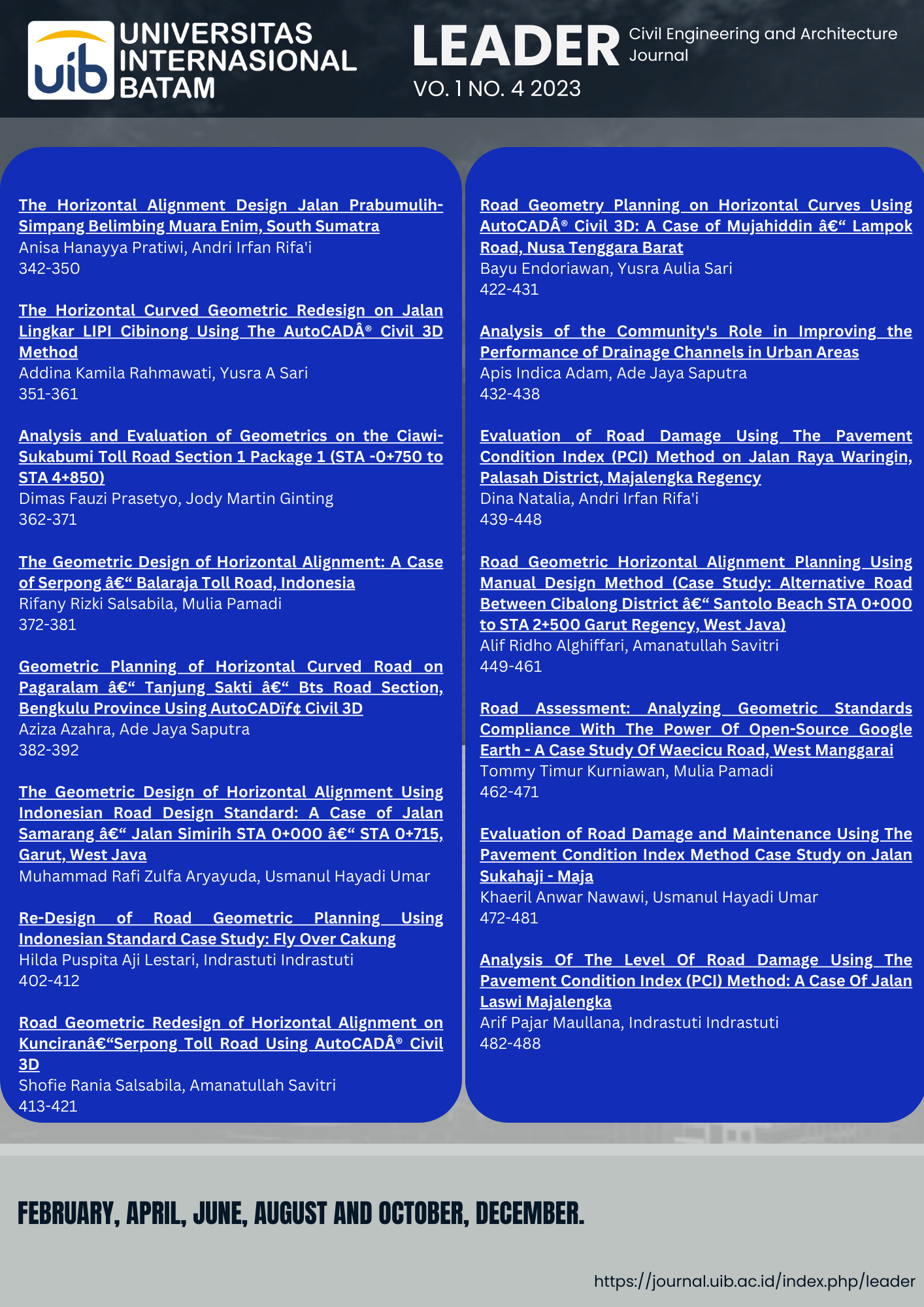Analysis of the Community's Role in Improving the Performance of Drainage Channels in Urban Areas
DOI:
https://doi.org/10.37253/leader.v1i4.8950Keywords:
Community role, drainage, performance, planning systemAbstract
This research, employing a literature review methodology, critically examines the pivotal role of community engagement in enhancing the efficacy of drainage channels within urban landscapes. As urbanization accelerates, the imperative for effective stormwater management to avert flooding and environmental degradation becomes increasingly apparent. The study synthesizes existing scholarly works to discern patterns and insights regarding the impact of community involvement on the performance of drainage systems. Key objectives involve investigating community awareness, understanding local knowledge pertaining to drainage challenges, and evaluating the outcomes of community-driven initiatives. By drawing on diverse literature sources, this research aims to provide a comprehensive overview of the factors influencing successful community participation and the barriers impeding such engagement. The findings derived from this literature-centric approach contribute nuanced perspectives to the discourse, informing urban planners and policymakers about evidence-based strategies to leverage community involvement for resilient and sustainable urban drainage systems.
Downloads
References
[2] D. Libora and A. J. Saputra, “Analysis of Water Resources, Public Health, and Economic Development in the Sungai Panas Region of Batam City,†LEADER: Civil Engineering and Architecture Journal, vol. 1, no. 3, pp. 324–330, 2023, doi: 10.37253/leader.v1i3.8303.
[3] A. J. Saputra and P. Fu, “ANALISIS PENERAPAN SISTEM RAINWATER TANK DI PERUMAHAN CITRA INDAH BATAM CENTER,†Jurnal Inersia, vol. 13, no. 1, pp. 31–40, 2021, doi: 10.33369/ijts.
[4] F. Fernando and A. J. Saputra, “Analysis of the Effect of Shear Walls on Building Structural Deviations in High-rise Buildings Monde City Tower M2 Batam City,†Journal of Civil Engineering and Planning, vol. 3, no. 2, pp. 146–160, Dec. 2022, doi: 10.37253/jcep.v3i2.7434.
[5] F. Hayatun Nikmah and A. J. Saputra, “Evaluation of the Impact of Increasing Population Density Against Water Resources in Coastal Areas,†LEADER: Civil Engineering and Architecture Journal, vol. 1, no. 3, pp. 211–218, 2023, doi: 10.37253/leader.v1i3.8273.
[6] A. E. Nurhamidin, M. I. Jasin, and F. Halim, “Analisis Sistem Drainase Kota Tondano (Studi Kasus Kompleks Kantor Bupati Minahasa),†Jurnal Sipil Statik, vol. 3, no. 9, pp. 599–612, 2015.
[7] A. J. Saputra, J. Sujono, and R. Jayadi, “KAJIAN HIDROLOGI DAN HIDRAULIKA BANJIR AKIBAT SIKLON TROPIS BADAI CEMPAKA 2017 DI DAS OPAK YOGYAKARTA,†Universitas Gadjah Mada, Yogyakarta, 2019.
[8] A. J. Saputra, J. Sujono, and R. Jayadi, “KAJIAN HIDROLOGI DAN ANALISA KAPASITAS TAMPANG SUNGAI OPAK YOGYAKARTA,†in Seminar Nasional Teknik Sumber Daya Air, 2019, pp. 173–185. [Online]. Available: https://www.researchgate.net/publication/348390321
[9] A. J. Saputra and Josephine, “Implementasi Rain Garden Infiltration untuk Mencapai Pembangunan Berkelanjutan dalam Pengelolaan Air Hujan,†vol. 19, no. 1, 2022, [Online]. Available: http://ejournal2.pnp.ac.id/index.php/jirs/TerakreditasiSINTAPeringkat5
[10] A. J. Saputra and Josephine, “Implementasi Rain Garden Infiltration untuk Mencapai Pembangunan Berkelanjutan dalam Pengelolaan Air Hujan,†vol. 19, no. 1, 2022, [Online]. Available: http://ejournal2.pnp.ac.id/index.php/jirs/TerakreditasiSINTAPeringkat5
[11] A. J. Saputra and P. Fu, “ANALISIS PENERAPAN SISTEM RAINWATER TANK DI PERUMAHAN CITRA INDAH BATAM CENTER,†J. Inersia, vol. 13, no. 1, pp. 31–40, 2021, doi: 10.33369/ijts.
[12] M. Dilla and A. D. Paerani, “Analisis Faktor-Faktor yang Berpengaruh terhadap Partisipasi Masyarakat dalam Pemeliharaan Saluran Drainase di Kelurahan Mannuruki Kota Makassar,†Jurnal Purifikasi, vol. 7, no. 2, pp. 97–102, 2006.
[13] S. A. Kholiq, “Analisis Saluran Drainase di Permukiman Padat ( Studi Kasus : Banjir di Jalan Lio Santa, Kecamatan Citamiyang, Kota Sukabumi,†Jurnal Student Teknik Sipil, vol. 3, no. 2, pp. 374–386, 2021.
[14] M. Fatahilah, “Jurnal Geografi,†Jurnal Geografi, vol. 10, no. 2, pp. 136–153, 2013.
[15] I. Wijaya and F. A. S. T, “Analisa Perencanaan Ulang Drainase ( Studi Kasus j2709alan Kh Wahid Hasyim Sempaja Samarinda ),†vol. 3, no. 2, 2022.
[16] T. Suliyati, “Penataan Drainase Perkotaan Berbasis Budaya Dalam Upaya Penanganan Banjir Di Kota Semarang,†Humanika, vol. 19, no. 1, p. 59, 2016, doi: 10.14710/humanika.19.1.59-69.







